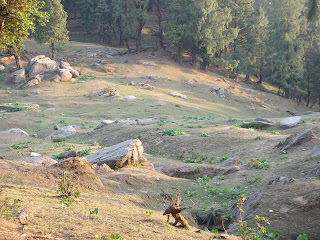THE enchanting Churdhar mountain in Sirmaur is one of the Shivalik ranges at a height of 11965 feet (it is the highest peak in southern Himachal Pradesh), Churdhar, commonly known as Churichandni (Bangle of Snow), is blessed with some of the most spectacular and beautiful landscapes in this region. The view from the summit embraces a vast panorama of lowland tracts towards the south and snow-capped ranges, including the peaks of Badrinath and Kedarnath in the Garhwal region, towards the north.
It is believed that this is the very place where Hanuman discovered the life-restoring Sanjivini booti,which revived Lakshmana, LordRama’s younger brother. Ruins of an ancient town have been discovered at the nearby Dundi Devi.
A wealth of herbs and beautiful alpine flora cover these Himalayan slopes. Walking through the wildlife sanctuary, one spots the spectacular monal, Himachal’s state bird, along with koklass and kaleej pheasants. The canine-toothed musk deer and the endangered Himalayan black bear inhabit the higher forests.
Below the summit is the deodar-roofed, single-storeyed, square temple of Srigul with a lingam, dedicated to Shiva (Chooreshwar Mahadev). Pilgrims sing and dance at night during the Navratras fair in this ancient temple.
Trekkers tread over small glaciers on their way to the wind-blown Churdhar summit, which has moderate to heavy snowfall (average of 33 feet snow). Often the Srigul temple gets buried under it.
On a clear sunny day, you can be rewarded with a view of the Badrinath and Kedarnath shrines, Gangetic plains, the Sutlej river and hills of Shimla and Chakrata. Atop the Churdhar summit lie the lingams of Shiva and Kali, where once goat and sheep were sacrificed. Devotees hoist flags and make offerings here.
It is believed that this is the very place where Hanuman discovered the life-restoring Sanjivini booti,which revived Lakshmana, LordRama’s younger brother. Ruins of an ancient town have been discovered at the nearby Dundi Devi.
A wealth of herbs and beautiful alpine flora cover these Himalayan slopes. Walking through the wildlife sanctuary, one spots the spectacular monal, Himachal’s state bird, along with koklass and kaleej pheasants. The canine-toothed musk deer and the endangered Himalayan black bear inhabit the higher forests.
Below the summit is the deodar-roofed, single-storeyed, square temple of Srigul with a lingam, dedicated to Shiva (Chooreshwar Mahadev). Pilgrims sing and dance at night during the Navratras fair in this ancient temple.
Trekkers tread over small glaciers on their way to the wind-blown Churdhar summit, which has moderate to heavy snowfall (average of 33 feet snow). Often the Srigul temple gets buried under it.
On a clear sunny day, you can be rewarded with a view of the Badrinath and Kedarnath shrines, Gangetic plains, the Sutlej river and hills of Shimla and Chakrata. Atop the Churdhar summit lie the lingams of Shiva and Kali, where once goat and sheep were sacrificed. Devotees hoist flags and make offerings here.
If you climb from nauradhar the initial track of 8 kilometers is a tough one and then comes the canteen owned by a localite in jaamnallah where one can get food along with an awesome scenic beauty of the place....As you move forward you come across the along the only water point found on the 18 km strech......then going through dense forests comes a windy place named Tissri...Never ever dare to pitch a tent here as it will be blown away by the winds.....here also one can find a canteen which provides noodles, tea, gums, food etc.... After a walk of half an hour, comes the toughest climb which is aroun 50 degree steep and is a very dangerous one.. On the top one can see the temple along with a big statue of lord SHIVA(Choodeshwar).
The track is tough and gets toughest at the initial climb and the final one....No demarcation has been made anywhere and lack of water adds to the problems of the trekkers. The ideal season to visit is April To July. .



No comments:
Post a Comment